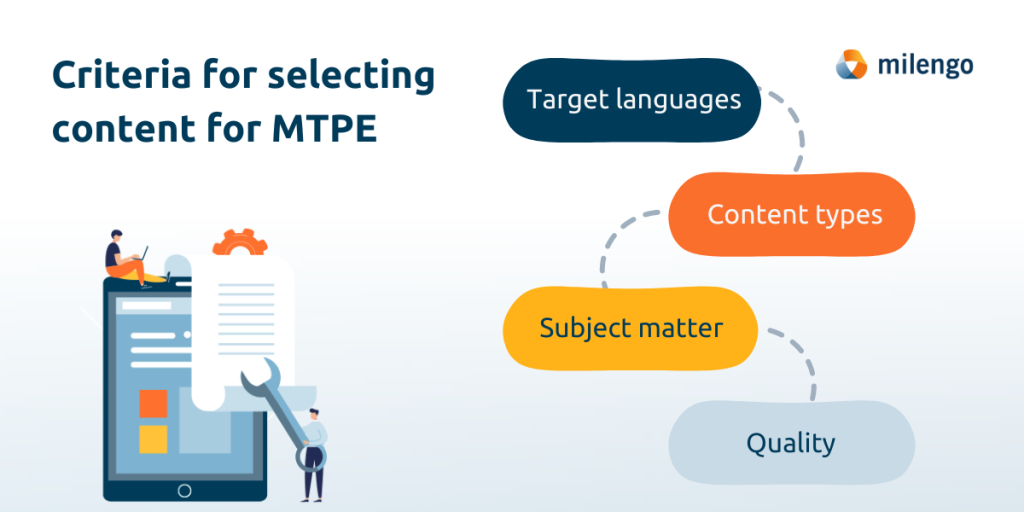Your Hands-on Guide to Post-editing

Does your company use AI translations (or want to start using it) to produce content in multiple languages? If so, this guide is for you!
Post-editing is a must for achieving high-quality AI translations. This hands-on guide to post-editing outlines key concepts, useful tips, and insights into what professional machine translation post-editing (MTPE) looks like in practice.
Ready to elevate your multilingual content with post-editing? Let’s go!
What is post-editing?
Post-editing is the editing and correction of machine-generated translation output. Put simply, a computer first creates a translation which is then edited by a human. This person is called the post-editor.
Their job is to make sure the translation meets a predefined quality standard by checking that the text is understandable and by correcting content errors.
Pro tip: Check out the ISO 18587 standard. It’s a great starting point into the world of machine translation and post-editing.
What are the benefits of post-editing?
First and foremost, post-editing translations lowers costs. An MTPE workflow is 30 to 80 percent cheaper than a human translation. Plus, the translation can be finished up to three times faster.
Having translations available quicker enables companies to launch products in international markets faster and communicate important information without delay. What’s more, texts that had previously been deemed too expensive to be translated are now back on the table.
Post-editing in practice : a step-by-step guide
In this next section, we’ll go through the five steps of how to implement a successful machine translation post-editing process for your company.
1. Perform a content audit
Every successful post-editing journey begins with a content audit. This establishes which of your texts are best suited to MTPE. The analysis should look at the following criteria.

Target languages
AI translation engines work really well with some languages, while with others it leaves something to be desired (here’s a ranking of the best language combinations for AI translators). It’s essential that you test the MT service you want to use (such as Google Translate) with each individual language combination. Industry reports such as Intento’s Machine Translation Report are a good place to find the latest information on how well MT systems perform.
Content types
Focus on informative texts that just need to be understood. Examples here include technical manuals, instructions, product descriptions, or online help. Content such as marketing (where transcreation is the best approach), software, and texts involving wordplay are less suitable.
Subject matter
Without further customization, machine translation engines mainly cope well with everyday language. But the output becomes less reliable when faced with highly specialized technical language (such as instructions for a 5-axis CNC milling machine) or jargon-heavy content (such as a blog post on gaming equipment).
Quality
Rule out texts that would require a creative or stylistically nuanced translation. If you’re unsure about what level of quality a text needs, then get in touch with the relevant person at your company to make sure you’re on the same page (take a look at the next section – “Define your post-editing quality expectations”).
Post-editing generally doesn’t achieve the same standard as human translation. Post-edited texts are often more rigid and literal than a translation produced by a human. Keep this in mind when selecting suitable content to avoid any issues later.
Is your content fit for machine translation?
Get a content audit with Milengo.
2. Define your post-editing quality expectations
Post-editing will only deliver reliable, consistent results if you have a crystal-clear definition of the quality level you need. This goes even more so for languages that you and your localization team aren’t overly familiar with.
The two classic quality levels are light post-editing (light PE) and full post-editing (full PE). The definitions below are just a guideline and can be adapted as needed.
Light post-editing
Light PE produces a text quality that is often described as “good enough”. The main aim of the process is to create a usable text. The translation might sound “literal” in places or as if it were translated by a machine, but the key thing is that the content is correct. Light PE is all about comprehensibility. Plus, it’s also 50 to 200 percent faster compared to human translation.
Full post-editing
Full PE aims to produce a result as close to human translation as possible. All the content should be present and correct, as well as be free from typos and grammar errors. The text should also use the correct technical terms and language. What it doesn’t deliver, however, is stylistic finesse or a translation adapted to the target market. Full PE is all about accuracy. Plus, it’s 25 to 50 percent faster than human translation.
Historically, translation quality has been difficult to define. While there are ISO standards in place, there aren’t any universally applicable quality standards for post-editing. We recommend downloading the post-editing guidelines linked below and adapting them over time based on your experience and feedback from your post-editors.
Which errors are corrected in each translation workflow?
| Raw machine translation | Light PE | Full PE | Human translation | |
|---|---|---|---|---|
| Accuracy of content | ❌ | Conveys the key messages of the source text | ✅ | ✅ |
| Offensive or culturally inappropriate language | ❌ | ✅ | ✅ | ✅ |
| Spelling and grammar | ❌ | ✅ | ✅ | ✅ |
| Sentence structure | ❌ | May be unusual | Syntax is correct | Optimized for readability and fluency |
| Style | ❌ | ❌ | Grammatically correct but not always idiomatic | Adapted to target audience and text type |
| Cultural adequacy | ❌ | ❌ | ❌ | ✅ |
| Terminology | ❌ | Key terminology is correct | ✅ | ✅ |
| Text flow | ❌ | ❌ | Only in terms of comprehensibility | ✅ |
| Consistent wording | ❌ | ❌ | ❌ | ✅ |
Experimental workflows
Monolingual post-editing is another approach to MTPE. This involves reviewing the machine output without checking the source text. The post-editor only focuses on the target text, which significantly speeds up the post-editing process, making it more cost-efficient.
This approach may be worth considering for languages where professional translators are in short supply. One disadvantage is that not consulting the source allows some errors to slip under the radar, meaning full equivalence between the source and target cannot be guaranteed.
MTPE workflows can also be designed to focus even more on quality. For instance, post-editing guidelines can include instructions about following in-house style guides or brand-specific language rules.
Want to learn more? Discover Milengo’s range of post-editing services.
Industry Insight: Look at industry association TAUS’ post-editing guidelines to give yourself a better idea about the common MTPE quality criteria.
3. Recruit post-editors
A good translator is by no means a good post-editor. Sometimes it’s even the opposite.
Post-editing is a fundamentally different task to translation. It’s all about speed and working with laser focus. MT engines also have very different strengths and weaknesses to humans, so the types of errors linguists have to look out for in the text aren’t the same.
What skills does a post-editor need?
Let’s start with the basics. As with translation, having excellent knowledge of the source language and a native speaker’s command of the target language are paramount.
In addition to this, they must be able to get to grips with new subject areas and research complex issues. Intercultural expertise and proficiency using common translation tools are also a must.
Having experience in the subject area and knowledge of relevant text type conventions is also crucial in post-editing. After all, post-editors often only have a fraction of the time to deal with ambiguities in the source text in comparison to a regular translation.
It’s also vital that they gain a solid understanding of machine translation technology – the so-called “machine translation literacy”): How does the engine itself work? Which engines are the most popular and what are their limitations? And what are the most common types of errors (take a look at the “Identify and correct errors” section)?
Mental resilience (see “The psychology of post-editing”) and an affinity for technology are also good soft skills to have.
In short, many companies underestimate what it takes to be a post-editor, which is why they need to select their candidates carefully and train them properly.
4. Train your post-editors

Here at Milengo, we’ve been using post-editing long before the hype surrounding machine translation began. We’ve drawn on our years of experience and came up with four important practical tips for you to pass on to your post-editors.
Beware the priming effect
Studies show that translators are heavily influenced by the raw output of machine translation. This is known as the “priming effect”, a phenomenon where post-editors stick too closely to the suggestion from the machine.
This isn’t surprising, since it can feel more daunting to edit a text that already seems to be correct than it is to write something from scratch. This results in post-editors overlooking translation errors, sticking with awkward, “literal” phrasing, and delivering a text that “sounds like a translation”.
The key to overcoming this mental block is to be aware of it while you’re working. You should also consider opting for human translation over post-editing for particularly sensitive texts.
Avoid over-editing
The aim of post-editing is to produce texts that are fit for purpose. Cost efficiency is the name of the game here, not replicating Shakespeare. Translators are often perfectionists by nature, and those with less experience tend to “go overboard” with preferential changes. However, a post-edited text doesn’t always have to be perfect to fulfill its purpose.
So which errors should actually be corrected? And what can be left as it is? Your post-editing guidelines should provide the answer.
The 5-second rule
Sometimes MT output is too poor for it to be worth correcting. In this case, post-editors have to translate the source text from scratch. But they need to make this decision quickly, with experts recommending taking a maximum of five to ten seconds before acting. They shouldn’t take too much longer to decide otherwise post-editing can end up taking even more time than a human translation would.
Read through the text again to fine tune it
AI translations don’t always manage to create fluent, natural sounding texts. Once you’ve finished your initial round of post-editing, it’s best to read through the text again to see where you can improve the flow and comprehensibility even further (particularly recommended for full post-editing). Make sure you ignore the source text altogether to avoid being influenced by it.
5. Identify and correct errors
AI translations are amazingly precise. However, scientific studies also reveal that not everything is always as it seems.
The root of the issue is that machine translation engines don’t “understand” human language. Instead, they produce translations based on semantic probabilities. As a result, machines generate unconventional translation errors that humans often miss during the post-editing process.
Train your post-editors to identify and correct these errors.
Below you will find a comprehensive overview to get you started. Use this list to determine which types of errors are most relevant for your use case. For instance, your technical documentation probably doesn’t need to flow like poetry. Document these preferences in your post-editing guidelines.
| Type of error | Description |
|---|---|
| Adaptation to the target audience | Not possible with machine translation |
| Branding | Corporate language and slogans are translated inconsistently |
| Cultural adaptation | Not possible with machine translation |
| Gender-sensitive language | Gender-neutral terms are used incorrectly |
| Length restrictions | Headings or software strings that are too long cause design conflicts |
| Intertextual references | References within a text are incorrect |
| Intratextual references | References to external texts are incorrect |
| Mistranslation | Uncommon words, idioms, and colloquial language are translated incorrectly |
| Proprietary names | Product names, brand names, acronyms, and more are mistranslated |
| Punctuation | For example, a decimal comma (“1,5”) is used instead of a decimal point (“1.5”) |
| Source text | Errors in the source text are replicated in the target |
| Syntax | The meaning of the text is unclear due to a misleading sentence structure |
| Style | The translation is too literal |
| Terminology | Technical terms are translated inconsistently |
| Text flow | Sentence transitions are clunky, text lacks rhythm |
| Text type conventions | Stylistic conventions for technical documentation, press releases, and other text types are disregarded |
| Tonality | The reader is addressed with the wrong level of formality |
| Untranslated | Words or entire paragraphs are left untranslated |
The psychology of post-editing

Although the role of post-editor has been around for almost 30 years, it remains strangely unclear.
One thing that is clear, however, is how much working conditions have improved over the years for post-editors. The quality of raw MT output has never been higher, which has boosted productivity and made the process easier.
But like any other job, being a post-editor also has its challenges – which is something to bear in mind when training and managing your post-editors. We have compiled a list of some of the psychological pitfalls of post-editing for you below.
Feeling detached from your work
The first time some translators take on a post-editing project, they complain they identify less with the text they produce. They say that they feel they’re simply checking the machine output rather than creating their “own” text. They also feel less engaged with the source text since they have to work twice as fast as in a regular translation to achieve the required throughput.
This feeling of detachment from your work, fueled by the increasing use of machines and automation, isn’t exclusive to the translation industry. It can be seen in many others as well. But if this problem isn’t taken seriously, your post-editors’ motivation will drop, and your translation team might see a higher turnover of members.
The solution:
Don’t think of your post-editors as “proofreaders”, but as language experts who actively help shape the post-editing process. Train them on how machine translation works and hold regular refresher sessions. In the long term, you should also consider involving them in the training and evaluation of machine translation systems. Helping post-editors to better understand their work and giving them more responsibilities can help them identify more with their role.
The fatigue effect
Working with machine translation is a stressful task that demands focus. You need to be able to maintain your composure and concentration. It’s common to have to post-edit 1,000 words of specialized text per hour. To make matters worse, some of the errors the machine makes are not easy to spot, while others are repeated ad nauseum. As a result, some translators perceive post-editing as more repetitive and tiring than traditional translation.
The European Commission’s translation department, which adopted post-editing workflows over a decade ago, is a cautionary tale here. While the new approach significantly boosted its translation volume, it came at a cost. According to Cristiano Sebastiani, President of EU trade union Renouveau et Démocratie, the number of reported mental health issues and cases of burnout also increased in this time.
The solution:
If your post-editors find their work too repetitive for too long, consider alternating between post-editing projects and normal translation projects. Working on different topics and text types can also provide variety. Make sure you only use machine translation for texts where the output quality needs to be good enough. Otherwise, you run the risk of frustrating your team.
Deprofessionalization
The aforementioned points are why many professional translators refuse to accept post-editing projects. This has created a shortage of well-trained post-editors. The situation is compounded by companies regularly underestimating the complexity of post-editing. They see it as correcting an “almost finished” translation that doesn’t require any senior editing expertise. As a result, post-editing projects tend to be paid at lower rates than regular translations.
This ends up with underqualified, “part-time” translators filling the gap and post-editing machine output, which in turn brings down the quality of the finished translation.
The solution:
Partner with an experienced translation agency such as Milengo. This will open the door to a carefully curated pool of qualified post-editors, proven quality assurance, and well-oiled processes.
What next?
Now that you have a comprehensive overview of post-editing, it’s time to put it into practice at your company. Make full use of these free resources and tips in this guide to help you improve your machine translation post-editing outputs.
As an experienced translation agency, we are also happy to support you – be it with professional post-editors, advice on technical issues, or help in selecting the best translation tool. We would be glad to discuss your needs in a no-obligation introductory call!



